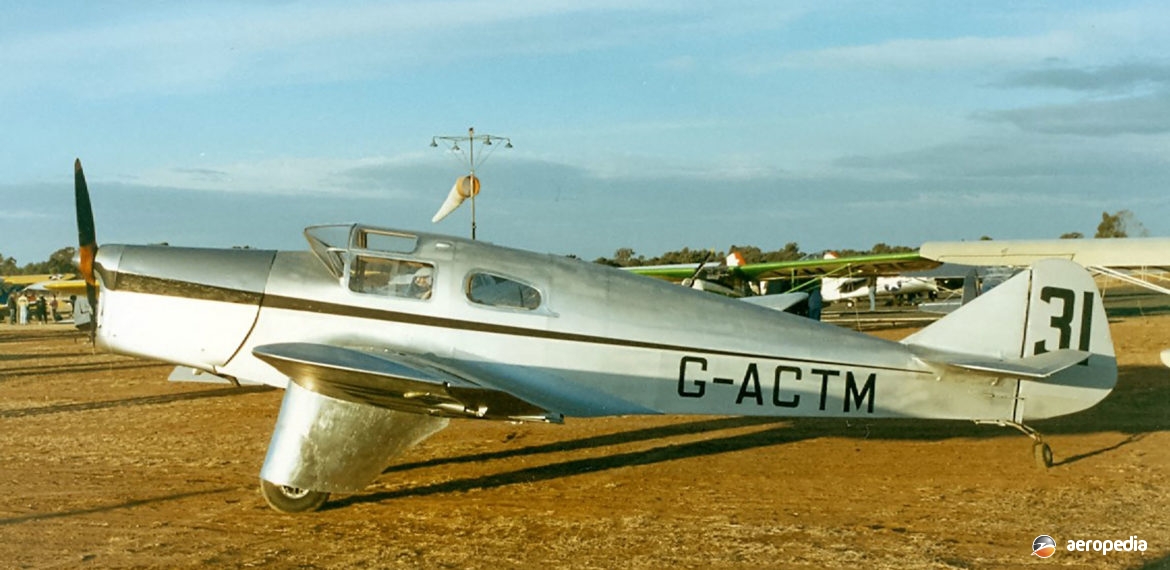Photograph:
Miles Falcon Major VH-AAT / G-ACTM (c/n 193) at Temora, NSW in April 1991 (David C Eyre)
Country of origin:
United Kingdom
Description:
Four-seat light touring monoplane
Power Plant:
One 97 kw (130 hp) de Havilland Gipsy Major four-cylinder in-line air-cooled engine
Specifications:
- Wingspan: 10.67 m (35 ft)
- Length: 7.62 m (25 ft)
- Height: 2 m (6 ft 6 in)
- Wing area: 16.2 m² (174 sq ft)
- Max speed: 233 km/h (145 mph)
- Cruising speed: 201 km/h (125 mph)
- Initial rate of climb: 229 m/min (750 ft/min)
- Service ceiling: 4,572 m (15,000 ft)
- Range: 990 km (615 miles)
- Empty weight: 590 kg (1,300 lb)
- Loaded weight: 998 kg (2,200 lb)
History:
The Falcon, a development of the M.2F and M.2H Hawk Major, which in turn were developed from the M.2 Hawk, was built to accommodate three persons in an enclosed cabin. The prototype G-ACTM (c/n 102 – ex U-3) was completed in 1934 and flown in the MacRobertson Air Race from the United Kingdom to Australia, but problems occurred so the journey took 27 days. However, its performance was better on the return journey. It left Darwin, NT on 23 March 1935 and reached Lympne, France 7 days, 19 hours and 15 minutes later. The longest non-stop stage on this flight was from Jodhpur in India to Basra in Iraq, a distance of 2,736 km (1,700 miles). Production of the series, which was undertaken by Phillips & Powis Aircraft Ltd of Reading in Berkshire, UK, amounted to a total of nineteen examples of the M.3A.
The first production machine G-ADBF (c/n 131) was flown in January 1935, and differed from the prototype in having four seats in a wider cabin, and a sloping windscreen. Production commenced with this model, with a Gipsy Major engine, and was known as the M.3A. At this time considerable interest was shown in air-racing in the United Kingdom, and a Falcon was fitted with a 149 kw (200 hp) de Havilland Gipsy Six engine. This aircraft G-ADLC (c/n 213) was known as the M.3B Falcon Six and seated three persons.
A further Gipsy Six engined aircraft was built with four seats, and this was known as the M.3C. In all 17 Gipsy Six engined machines were built but, other than the prototype during the 1934 MacRobertson Air Race, only VH-ABT (c/n 266), owned by R Hamblin, reached Australia. During World War II it was impressed and flown by the RAAF as A37-1. It then returned to civil use in August 1946, at one stage being owned by J M Bonney of Manara, via Cobar, NSW, and at another time by W J Robinson of Rowville, VIC. It was withdrawn from service on 22 August 1959.
Three M.3A Falcons were registered in Australia: VH-ACE (c/n 202 – ex G-AIDU) was first registered in March 1937 to E B Jones who traded as Airwork Co of Aerodrome, Coopers Plains, QLD. It was used by the RAAF as A37-6 during the war. It was eventually reduced to parts. VH-AAT (c/n 193 – ex G-ADHG), first registered in July 1937 to the Royal Queensland Aero Club, was used by the RAAF as A37-3 during the war. It was restored in 1946 and at one stage was owned by Schutt Aircraft Pty Ltd of Moorabbin, VIC. On 9 February 1951 it crashed at Echuca, VIC. It was again restored and again registered in August 1959, having a number of owners, including A Hume of Hobart, TAS in 1961, H T Burgess of Geeveston, TAS in 1970, D J R Barker of Caloundra, QLD in 1974 and L K Hatfield of Berwick, VIC. It is airworthy. At one stage it was painted as the prototype G-ACTM for a television series. VH-AAS (c/n 209) was first registered in July 1936 for Schutt Aircraft Pty Ltd of Moorabbin. It crashed at Hatches Creek in the Northern Territory on 23 July 1940.
One M.3B Falcon Major was registered in New Zealand. ZK-AEI (c/n 247) was purchased new in 1935 for Union Airways but crashed on 19 February 1936. At least two examples survive overseas, G-AAEG in the United Kingdom and EC-ACB in Spain.

